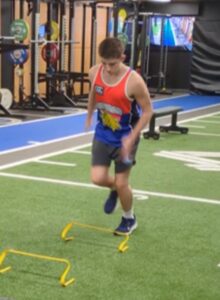Have you recently suffered an ankle sprain while playing sports? Are you struggling to get back onto the playing arena and performing your best?
At MCAP, ankle sprains are one of the most commonly seen injuries. This article will help you gain a better understanding of ankle sprains, what to expect, and how to manage them. Let us help you get back to being better!
Read more about returning to sport following a hamstring injury here.
UNDERSTANDING ANKLE SPRAINS
It is essential to understand the nature of ankle injuries and their implications for returning to sport. Ankle injuries commonly involve damage to the ligaments, such as the anterior talofibular ligament (ATFL), posterior talofibular ligament (PTFL), and calcaneofibular ligament (CFL). The injury often results from sudden twists, turns, or impacts.

TYPES OF ANKLE SPRAINS
There are also different types of ankle sprains which can be characterised into different grades based on the severity of the injury:
1. Grade 1 (Mild): This involves stretching or slight tearing of the ligament fibres, causing mild tenderness and swelling. There may be minimal loss of function, and individuals can usually bear weight on the affected ankle.
2. Grade 2 (Moderate): This involves a partial tear of the ligament fibres, resulting in more significant pain, swelling, and bruising. Weight-bearing is often difficult, and some ankle instability.
3. Grade 3 (Severe): This is a complete tear or rupture of the ligament, causing severe pain, swelling, bruising, and significant instability of the ankle joint. Weight-bearing is usually impossible without support.
SIGNS AND SYMPTOMS OF AN ANKLE SPRAIN
The signs and symptoms of an ankle sprain can vary depending on the severity but commonly include:
- Pain, particularly when bearing weight or moving the ankle
- Swelling or bruising around the ankle joint
- Tenderness to touch
- Instability or a feeling of giving way in the ankle
- Restricted range of motion
Returning to sport after an ankle injury poses several challenges. Athletes may face physical limitations such as impaired running, jumping and landing mechanics, and increased risk of reinjury.
When returning to sport, it is important to focus on different phases of rehabilitation. These include:
1. Restoration Phase: Focuses on reducing pain and swelling, restoring range of motion, and beginning gentle strengthening exercises.
2. Functional Rehabilitation: Emphasises sport-specific exercises and activities.
3. Return to Sport: Involves drills and simulations to assess ankle readiness.

REHABILITATION PRINCIPLES
Successful rehabilitation following an ankle injury hinges on adhering to fundamental principles aimed at restoring strength, function, and stability of the ankle. These principles include:
1. Early Management: Initiate the R.I.C.E. protocol to minimise swelling and inflammation.
2. Pain Control: Manage pain through ice therapy, (NSAIDs), and manual techniques.
3. Range of Motion: Gradually restoring ankle ROM through gentle stretching and mobility exercises. Stiffness and maintaining joint flexibility.
4. Strength and Stability: Strengthening muscles around the foot and ankle to enhance joint stability.
5. Proprioception and Balance: Incorporate proprioceptive and balance training exercises to improve ankle control.
CONCLUSION
Returning to sport after an ankle injury is a challenging but achievable goal with the right approach to rehabilitation and a commitment to the recovery process.
At MCAP, our physiotherapists understand the demands of AFL on ankle sprains. Our team specialises in designing personalised rehabilitation programs tailored to your injury and athletic goals. We combine cutting-edge technology with evidence-based practices to ensure a safe, effective, and fast return to sport.